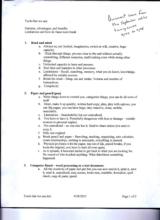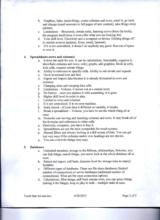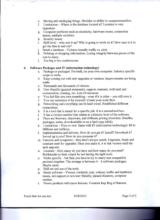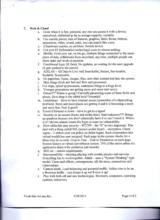|
Basic Assignments
|
Options & Settings
|
Main Time Information
|
||||||||||||||||||||||
|
|
|
|
|
||||||
|
||||||
|
|
|
Notes:
|
|
This Document came from the September adilas training course, 9/24-9/26/2013: Tools that we use: Features, advantages, and benefits: Limitations and how do these tools break: 1. Head and mind a. Always on, not limited, imagination, switch at will, creative, huge capacity. b. Think through things, process clear to the end without actually committing, different scenarios, multi-tasking even while doing other things. c. Unlimited capacity to learn and process. d. Start here and translate to other processes. e. Limitations – Recall, searching, memory, what you do know, knowledge, affected by outside sources. f. Break the mind – sleep, eat, and intake. Volume and number of transactions. g. Complexity 2. Paper and pencil (pen) a. Write things down to remind you, categorize things, you can do all sorts of stuff. b. Draw, make it up quickly, written hard copy, plan, play with options, you can flip pages, you can have huge, tiny massive, erase, mobile, searchable. c. Limitations – Search-ability but not centralized. d. You have to have it. Potentially dangerous with loss or damage – outside sources or personal neglect. e. Not centralized – no one else has it. Hard to share unless you send or copy it. f. Only one original. g. Break pencil and paper – searching, stacking, organizing, auto calculate, create relationships, nothing is automatic, everything is manual. h. Physical problems with paper, run out of ink, pencil breaks, if you lose the original, you have to start all over again. i. As it spreads, it becomes harder to get back to what you are looking for. No record of who touched anything. What date/times some things happened. 3. Computer Based – word processing or a text document a. All the creativity of paper and pen but you can now search it, print it, save it, send it, centralized, easy access, looks nice, readable, formatted, spell check, copy & paste, speed. b. Graphics, links, insert things, create columns and rows, email it, go back and change (small amounts to full pages of new content), take things away (delete). c. Limitations – structured, certain rules, learning curve (learn the tools), the program itself (does it even offer what you are looking for). d. Your skill level. Electricity and a computer or device. Dishing off to outside sources (printers, faxes, email, Internet). e. If it is not centralized, it doesn’t do anybody any good. Run out of space to save it. 4. Spreadsheets (rows and columns) a. It does the math for you. It can do calculations. Searchable, organize it, show/hide columns and rows, color, graphs, add graphics, block in cells, lock cells, connect certain things. b. Ability to reference to specific cells. Ability to sub divide and expand. c. Good structured look and feel. d. Export and Import data because it is already formatted in rows and columns. e. Changing sizes and merging data cells. f. Limitations – volume. It maxes out at a certain level. g. No history – once you replace it with something, it is gone. h. Higher skill level in order to play. i. Limited to rows and columns. j. It is not centralized. It is on your machine. k. Static layout – If your data is different or variable, it breaks. l. Break a spreadsheet – volume, you have to see the whole thing at once. m. Formulas and moving and inserting columns and rows. It may break all of the formulas and references to other cells. n. Electricity, computer, you have to buy it. o. Spreadsheets are not the most compatible for touch screens. p. Manual filters and always looking at a full screen of data. You can get lost very easy if the columns and/or row headings are not shown. q. You can overwrite things very easy. 5. Databases a. Unlimited structure, storage in the billions, relationships, histories, you can link things, search things, you never look at the whole database all at once. b. Return and report, call back, dynamic level for storage (one-to-many). Scalable. c. Different types of databases. There are file share databases (limited number of connections) or server databases (unlimited number of connections). What are the open connection options. d. Calculations, filter things, pull back certain rows, you can query things (asking it for things), loop or play in bulk – multiple tasks at once. e. Storing and cataloging things. Modular or ability to compartmentalize. f. Limitations – Where is the database located at? Location is very important. g. Computer problems such as electricity, hardware issues, connection issues, multiple variables. h. Security issues. i. Skill level – who sets it up? Who is going to work on it? How easy is it to get the data in and out? j. Break a database – volume (usually traffic vs. size). k. Deleting or dropping information. Losing integrity between pieces of the one-to-many. l. Too big or cumbersome. 6. Software Packages and IT (Information Technology) a. Package or packaged. Pre-built, on your own computer. Industry specific scope or niche. b. Keep coming out with new upgrades or versions. Improvements are being made. c. Thousands and thousands of choices. d. User friendly (general statement), support, manuals, well used and communities, training, etc. Lots of resources. e. You feel like you own something – even if it is older – you still own it. f. You can customize it for yourself. Create you work flow. g. Networking and everything can be hard wired. Established different connections. h. It is a tool that is meant for a specific job. It is a catered tool box. i. It has a version number that related to a historic level of the software. j. There are freeware, shareware, and different pricing structures. Bundles, packages, suites, downloadable or on a hard copy (disk). k. Limitations – price or cost. Same with IT (information technology). $0 to millions and millions. l. Implementation and delivery. How do you get it? Install? Download it? Served up to you? How do you consume it? m. Versions and computers – they don’t always match. Upgrades. Static and constant need for upgrades. Once you make it, it is that version until the next upgrade. n. Licenses – how many do you have and how many do you need? Bottlenecks of limit output by not having the right tools. o. Niche specific – but then you have to try to marry non-compatible products together. The average is between 4-6 software packages. Maybe more. p. Skill set and use of the tools. q. Break software – viruses, outdated, cost, volume, traffic, and hardware issues, not support of non-user friendly, natural disasters, computer crashes. r. Newer products with more features. Constant leap from of features. 7. Web & Cloud a. Great when it is fast, personal, anyone can access it with a device, centralized, unlimited as far as storage capacity, versatile. b. Use outside pieces, tons of features, graphics, links, form, buttons, animations, video, sound, print, you can search like crazy. c. If hardware crashes, no problem, switch device. d. Cut you IT (information technology) costs to almost nothing. e. Mobile. From your car, on the go, multiple things connected to the same pieces of data, collaborate from anywhere, anytime, multiple people can share tasks and work on projects. f. Conditional logic (if, then). NO updates, no waiting for the next upgrade (it gets pushed to the server). g. ADILAS – All Data Is Live And Searchable, Secure, Serviceable, Scalable, Sustainable. h. Go paperless. Scans, images, files, and other content tied into the system. i. Skin things (look and feel and flow and processes). j. Cut steps, speed up processes, customize things to a huge level. k. Younger generations are getting more and more tech savvy. l. Future??? Where is it going? Currently pioneering some of these fields and places. How deep is the rabbit hole? Potential! m. Limitations – Have to have Internet access (somewhat of a diminishing problem). More and more places are getting it and access is becoming free more and more. Free is good! n. Travel if Internet is down – have to get to a signal. o. Security or un-secure (hacks and stolen data). Semi unknown??? Brings up question because you don’t physically have it or can’t touch it. Where is it? Movies almost create this hype or scare on vulnerability. p. How adilas.biz uses security – HTTPS – the “S” is very important. This deals with a thing called SSL (secure socket layer) – encryption. Check logins – 3 strikes you’re out policy on failed logins. Each corporation (aka virtual world) has users assigned. Each page in the system checks for a three-way tie or code. Corp to User – User to Permission on each page. System history or virtual surveillance system. 75% of the entire adilas.biz application deals with validation and security. q. Skill set – certain requirements. r. Interoperability – meaning playing with outside players and service. Everything has to work together. Adilas – uses a “System Thinking” type model. Cause and effects, consequences, tell the story, connections and relationships. s. Custom needs. Load balancing and potential traffic. Adilas tried to be an e-Business buffet – you dream it up, we’ll wire it up! t. Play with both old and new technologies. Browsers, computers, operating systems, unknowns. 8. API or Custom (application programming interface) 9. World Building (stories and movies – ultra custom level) |





